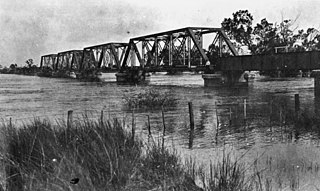Nogoa River
| Nogoa | |
|---|---|
 Railway bridge in Emerald during a flood, 1918 | |
Location of Nogoa River mouth in Queensland | |
| Location | |
| Country | Australia |
| State | Queensland |
| Region | Central Queensland |
| City | Emerald |
| Physical characteristics | |
| Source | Carnarvon Range |
| • location | Carnarvon National Park |
| • coordinates | 24°51′38″S 147°00′16″E / 24.86056°S 147.00444°E |
| • elevation | 501 m (1,644 ft) |
| Mouth | confluence with Comet River, forming the Mackenzie River |
• location | north of Comet |
• coordinates | 23°33′21″S 148°32′11″E / 23.55583°S 148.53639°E |
• elevation | 144 m (472 ft) |
| Length | 569 km (354 mi) |
| Basin size | 27,690 km2 (10,690 sq mi)[1] |
| Basin features | |
| River system | Fitzroy River basin |
| National parks | Carnarvon National Park, Minerva Hills National Park, Peak Range National Park, Snake Range National Park |
| [2] | |
The Nogoa River is a river in Central Queensland, Australia.
Course and features
The river rises on the
The river has a
The reservoir created by Queensland's second largest dam,[3] Lake Maraboon was formed when the Fairbairn Dam was built on the river in 1972. The dam and a network of channels along the Nogoa River supplies water for the Emerald Irrigation Area.[4]
Sir Thomas Mitchell was the first European explorer to discover the river on 19 July 1846.[5]
Major flooding events
In January 2008, the Nogoa River reached record flood levels. During the flood, water levels in the Fairbairn Dam rapidly exceeded 100%.
In December 2010 - January 2011 the river was impacted by major flooding at Emerald[9] and in the Nogoa's upper catchment.[10]
Cultural Heritage
The
See also
References
- ^ a b "Nogoa River drainage sub-basin". WetlandInfo. Department of Environment and Heritage Protection, Queensland Government. Retrieved 21 November 2015.
- ^ a b "Map of Nogoa River, QLD". Bonzle Digital Atlas of Australia. Retrieved 19 November 2015.
- ^ "Fairbairn Dam performed well during Emerald's major flood event" (Press release). SunWater. 4 February 2008. Archived from the original on 22 November 2015. Retrieved 21 November 2015.
- ^ "Water resources - Overview - Queensland - Basin & Surface Water Management Area: Nogoa / Mackenzie". Australian Natural Resources Atlas. Department of the Environment, Water, Heritage and the Arts. Archived from the original on 22 June 2009. Retrieved 20 May 2009.
- ^ "Nogoa River (entry 24444)". Queensland Place Names. Queensland Government. Retrieved 19 November 2015.
- ^ "Drought-stricken Fairbairn Dam overflows". 19 January 2008. Retrieved 20 January 2008.
- The Brisbane Times. Retrieved 20 May 2009.
- ^ Morley, Peter (26 April 2008). "Central Highlands dragline a costly rust bucket". The Courier-Mail. Queensland Newspapers. Archived from the original on 27 April 2008. Retrieved 20 May 2009.
- Central Highlands Regional Council. Retrieved 21 November 2015.
- Central Highlands Regional Council. Retrieved 21 November 2015.
- CC-BY-4.0 licensed text from: "Gayiri". Queensland Aboriginal and Torres Strait Islander languages map. State Library of Queensland. Retrieved 5 February 2020.

